Harbor
 From Handwiki
From Handwiki 

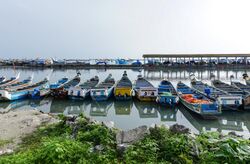
A harbor (American English), harbour (British English; see spelling differences), or haven is a sheltered body of water where ships, boats, and barges can be docked. The term harbor is often used interchangeably with port, which is a man-made facility built for loading and unloading vessels and dropping off and picking up passengers. Harbors usually include one or more ports. Alexandria Port in Egypt is an example of a harbor with two ports.
Harbors may be natural or artificial. An artificial harbor can have deliberately constructed breakwaters, sea walls, or jetties or they can be constructed by dredging, which requires maintenance by further periodic dredging. An example of an artificial harbor is Long Beach Harbor, California , United States, which was an array of salt marshes and tidal flats too shallow for modern merchant ships before it was first dredged in the early 20th century.[1] In contrast, a natural harbor is surrounded on several sides by land. Examples of natural harbors include Sydney Harbour, New South Wales, Australia, Halifax Harbour in Halifax, Nova Scotia, Canada and Trincomalee Harbour in Sri Lanka.
Artificial harbors
Artificial harbors are frequently built for use as ports. The oldest artificial harbor known is the Ancient Egyptian site at Wadi al-Jarf, on the Red Sea coast, which is at least 4500 years old (ca. 2600-2550 BCE, reign of King Khufu). The largest artificially created harbor is Jebel Ali in Dubai.[2] Other large and busy artificial harbors include:
- Port of Houston, Texas , United States
- Port of Long Beach, California, United States
- Port of Los Angeles in San Pedro, California, United States
- Port of Rotterdam, Netherlands
- Port of Savannah, Georgia, United States
The Ancient Carthaginians constructed fortified, artificial harbors called cothons.
Natural harbors
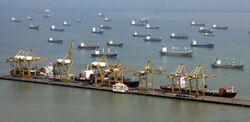
A natural harbor is a landform where a section of a body of water is protected and deep enough to allow anchorage. Many such harbors are rias. Natural harbors have long been of great strategic naval and economic importance, and many great cities of the world are located on them. Having a protected harbor reduces or eliminates the need for breakwaters as it will result in calmer waves inside the harbor. Some examples are:
- Bali Strait, Indonesia
- Berehaven Harbour, Ireland
- Balikpapan Bay in East Kalimantan, Indonesia
- Mumbai in Maharashtra, India
- Boston Harbor in Massachusetts , United States
- Burrard Inlet in Vancouver , British Columbia, Canada
- Chittagong in Chittagong Division, Bangladesh
- Cork Harbour, Ireland
- Grand Harbour, Malta
- Guantánamo Bay, Cuba
- Gulf of Paria, Trinidad and Tobago
- Haifa Bay, in Haifa, Israel
- Halifax Harbour in Nova Scotia, Canada
- Hamilton Harbour in Ontario, Canada
- Killybegs in County Donegal, Ireland
- Kingston Harbour, Jamaica
- Marsamxett Harbour, Malta
- Milford Haven in Wales, United Kingdom
- New York Harbor in the United States
- Pago Pago Harbor in American Samoa
- Pearl Harbor in Hawaii, United States
- Poole Harbour in England, United Kingdom
- Port Hercules, Monaco
- Sydney Harbour in New South Wales, Australia, technically a ria
- Port Stephens in Australia
- Tanjung Perak in Surabaya, Indonesia
- Port of Tobruk in Tobruk, Libya
- Presque Isle Bay in Pennsylvania, United States
- Prince William Sound in Alaska, United States
- Puget Sound in Washington (state) , United States
- Rías Altas and Rías Baixas in Galicia, Spain
- Roadstead of Brest in Brittany, France
- San Francisco Bay in California, United States
- Scapa Flow in Scotland, United Kingdom
- Sept-Îles in Côte-Nord, Quebec, Canada
- Shelburne in Nova Scotia, Canada
- Subic Bay in Zambales, Philippines
- Tampa Bay in Florida, United States
- Trincomalee Harbour, Sri Lanka
- Tuticorin in Tamil Nadu, India
- Victoria Harbour in Hong Kong
- Visakhapatnam Harbour, India
- Vizhinjam in Trivandrum, India
- Waitemata Harbour in Auckland, New Zealand
- Manukau Harbour in Auckland, New Zealand
- Port Foster in Deception Island, Antarctica
Ice-free harbors
For harbors near the North and South poles, being ice-free is an important advantage, especially when it is year-round. Examples of these are:
- Hammerfest, Norway
- Liinakhamari, Russia
- Murmansk, Russia
- Nakhodka in Nakhodka Bay, Russia
- Pechenga, Russia
- Prince Rupert, Canada
- Valdez, United States
- Vardø, Norway
- Vostochny Port, Russia
The world's southernmost harbor, located at Antarctica's Winter Quarters Bay (77° 50′ South), is sometimes ice-free, depending on the summertime pack ice conditions.[3]
Important harbors


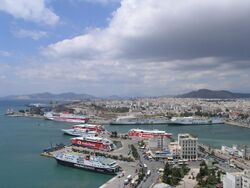
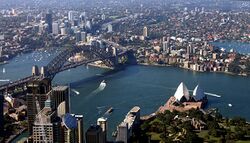
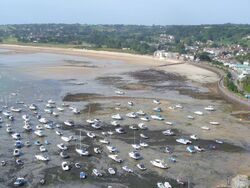

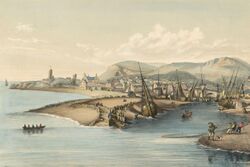
Although the world's busiest port is a contested title, in 2017 the world's busiest harbor by cargo tonnage was the Port of Ningbo-Zhoushan.[7]
The following are large natural harbors:
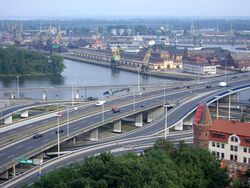

See also
- Boyd's Automatic tide signalling apparatus
- Dock
- Ice pier
- Inland harbor
- List of marinas
- List of seaports
- Mandracchio
- Marina
- Mulberry harbour
- Quay
- Roadstead
- Seaport
- Shipyard
- Wharf
Notes
- ↑ "Geology 303 Ch 8 Los Angeles and Long Beach Harbors". http://geology.campus.ad.csulb.edu/people/bperry/geology303/geol303chapter8.html.
- ↑ Hattendorf, John B. (2007), The Oxford encyclopedia of maritime history, Oxford University Press, p. 590, ISBN 978-0-19-513075-1
- ↑ U.S. Polar Programs National Science Foundation FY2000.
- ↑ "Circuit Guide | Punta del Este, Uruguay". FIA Formula E. http://www.fiaformulae.com/en/calendar/2014-punta-del-este/punta-del-este-circuit.aspx.
- ↑ "Formula E reveals circuit for Punta del Este ePrix". FIA Formula E. 2014-06-20. http://www.fiaformulae.com/en/news/2014/june/formula-e-reveals-circuit-for-punta-del-este-eprix.aspx.
- ↑ "Formula E unveils Punta del Este circuit in Uruguay". autosport.com. 2014-06-20. http://www.autosport.com/news/report.php/id/114541.
- ↑ "Global Port Development Annual Report (2017)". http://en.sisi-smu.org/index.php?c=article&id=16280.
External links
- Harbor Maintenance Finance and Funding Congressional Research Service
 "Harbor". New International Encyclopedia. 1905.
"Harbor". New International Encyclopedia. 1905.
it:Porto tt:Лиман
 |
Categories: [Coastal construction] [Nautical terminology] [Bodies of water]
↧ Download as ZWI file | Last modified: 08/09/2024 12:25:41 | 23 views
☰ Source: https://handwiki.org/wiki/Earth:Harbor | License: CC BY-SA 3.0

 KSF
KSF